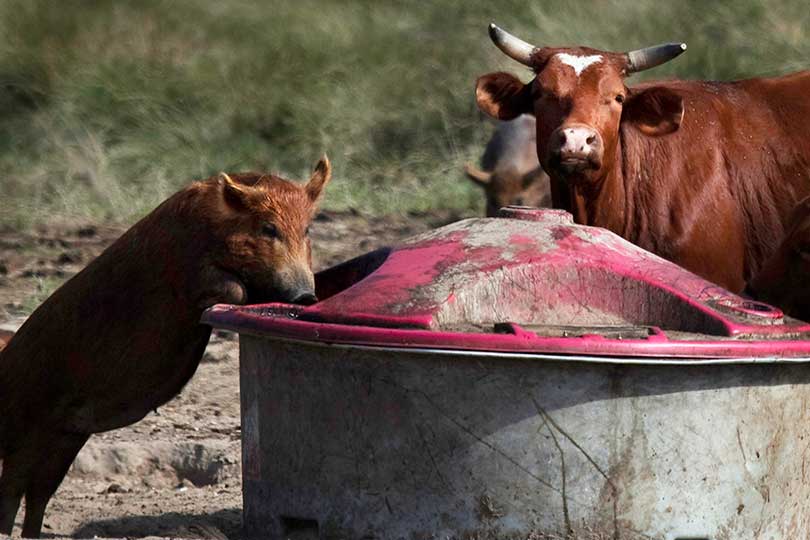By Landee Kieschnick
TFB Communications Intern
Wild pigs, a species that seems to reproduce faster than landowners can manage, have wreaked havoc on the Lone Star State for countless years.
As deer season winds down and planting season begins, wild pigs will become more active by uprooting crops and pasture land in search of food.
“Food sources begin to dry up, and pigs need to become more active in order to obtain food,” Dr. Billy Higginbotham, Texas A&M AgriLife Extension Wildlife and Fisheries specialist, told the Texas Farm Bureau (TFB) Radio Network. “This is going to make wild pigs a little more vulnerable for control.”
Wild pigs are found throughout much of the state with the highest populations in East, South and Central Texas.
“Many farmers may not have any hogs until they start planting. All of a sudden, wild pigs start tearing up freshly planted fields,” Gene Richardson, director of Commodity and Regulatory Activities, said.
Landowners have tried tracking, hunting with dogs and helicopter services, but a method that seems to be successful and the first line of defense is trapping.
“A successful corral trap needs to have a minimum of five-foot high panels. Most of these panels will be 16 to 20 feet in length, and just as important, these panels need to have a four-inch mesh to retain even the smallest of pigs caught,” Higginbotham said.
Just like waiting for a crop to grow, it takes time for the wild pigs to start baiting a corral trap.
“Wild hogs are very intelligent, causing landowners a lot of money by damaging crops and equipment,” Richardson said. “They can be in one place one night and another the next night. It’s very difficult to go out and find them when trying to do something about it.”
Once a wild pig has been caught, a trapper can take their pigs to more than 100 buying stations in Texas, which purchase live pigs and provide immediate payment, or they can be harvested in the field.
Higginbotham advised that whether the pig was harvested in the field or caught in a trap, the right precautions need to be taken to ensure good management and hygiene practices.
When field dressing a wild pig, Higginbotham recommends wearing latex or rubber gloves, along with eye protection, to help prevent exposure of any blood or bodily fluids.
After the pig is field dressed, cool the meat down as quickly as possible, and when time to eat, make sure to reach an internal temperature of 165 degrees to prevent any risk of illness.
To help landowners manage wild pig populations, the Texas A&M AgriLife Extension Wildlife Services and Texas Parks and Wildlife Department host monthly programs, as well as field visits to determine the best management in your direct area. Program dates can be found at http://today.agrilife.org/articles/.


We have wild hogs in Limestone County, I have tried trapping them with corn, but have ended up catching a young deer, I have released them with little or no injury, so have given on trapping hogs. Can you advise me on what to bait with that deer on eat ?
Hi, Patsy. You can find more information on feral hogs through the AgriLife Extension Service: http://agrilifeextension.tamu.edu/solutions/feral-hogs/.
Three invasions during the last 1-2 years.
How to interpret when the next will be?
Is it true that the hogs follow the water ways including the smaller creeks?
Should traps be placed near the river banks or shoreline of slow moving streams?
Are herd size enclosures using cattle panels and a one way door flap effective?
Does the top need to be covered with wire e.g. over a 60″x20′ series of panels?
Is it true that to escape hogs will climb on the backs of other hogs to jump higher?
Is whole corn as good as anything?
What if any additives are advised?
Does the corn need to be soured and fermented to be effective?
Does corn need to be in a hole or simply on the ground beneath the trigger of the trap?
Do hog wallows need to be developed and if existing or created to be baited?
Is it true that it is preferred that whole corn be also scattered around and not just inside a hog trap?
Any other hog trapping “pearls” that you might offer a novice?
I have heard mixed anecdotes about measures that might reduce the odor and offensive taste of an intact boar? Short of trapping them, castrating and releasing them, only to trap again, seemingly quite unlikely that they would want to hang around, are there any measures advised to make the flesh of boars less offensive?
Thank you,
Ronald Tolls
rtolls@gmail.com
Extra Mile Ranch
Livingston, TX
What is the preferred bait?
Does corn need to be fermented or sour?
Are commercial attractant additives worth the expense?
Supposedly hogs travel rivers and streams. Should traps be placed where the damage is being done or stream?
Having had some three hog invasions during the last several years, are their return predictable or erratic?
What if any can actually be done to make the flesh of boar less offensive short of castration, confinement, etc?
Is it a waste of corn to scatter it in the periphery of a hog trap, in wallows, or is corn over the trigger of trap O.K.?
Any additional “pearls” for a novice fro an expert would be appreciated.
Thank you,
Ronald Tolls
Extra Mile Ranch
Livingston, TX
936 327 5403 or
580 678 9155 or
580 678 9a34
rtolls@gmail.com
Come on Guys: a “coral”? Really? You are putting wild pigs in the ocean?
Thanks for bringing it to our attention, B. Horton. We all make mistakes, but we’ve corrected the spelling. Thanks! :)
If my crops get dug up by wild boars, am I covered by insurance?
Is there any one out there that would let a group of guys come hog hunting my phone 7342920776